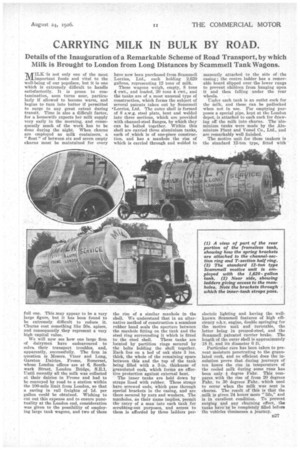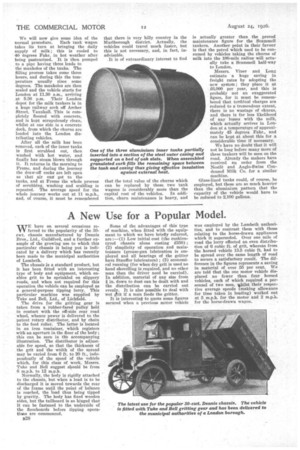CARRYING MILK IN BULK BY ROAD.
Page 45

Page 46

If you've noticed an error in this article please click here to report it so we can fix it.
Details of the Inauguration of a Remarkable Scheme of Road Transport, by which Milk is Brought to London from Long Distances by Scammell Tank Wagons.
MILK -is not only one of the most important foods and vital to the well-being of our populace, but it is one which is extremely difficult to handle satisfactorily. It is prone to contamination, soon turns sour, particularly if allowed to become warm, and begins to turn into butter if permitted to surge to any great extent during -transit. Time is also a difficult factor, for a housewife expects her milk supply very early in the morning, and consequently much of the work has to be done during the night. When churns are employed as milk containers, a "
float" of between six and seven empty churns must be maintained for every full one. This may appear to be a very large figure, but it has been found to be extremely difficult to reduce it. Churns cost something like 50s. apiece, and consequently they represent a very high capital value.
We will now see how one large firm of dairymen have endeavoured to solve, their transport troubles, and, apparently, successfully. The firm in question is Messrs. Viner and Long, Gersten Dairies, Frome, Somerset, whose London offices are at 6, Southwark Street, London Bridge, S.E.1. Until recently all the milk was collected at their dairies in Frome and had to be conveyed by road to a station within the 100-mile limit from London, so that a saving in rail freights of 1d. per gallon could be obtained. Wishing to cut out this expense and to ensure punctuality at the London end, consideration was given to the possibility of employing large tank wagons, and two of these have now been purchased from Scammell Lorries, Ltd., each holding 2,620 gallons, representing 12 tons of milk.
These wagons weigh, empty, 8 tons 4 cwt., and loaded, 20 tons 4 cwt., and the tanks are of a most unusual type of construction, which forms the subjeet of several patents taken out by Scammell 'Lorries, Ltd. The outer shell is formed of 8 s.w.g. steel plate, bent and welded into three sections, which are provided with channel-steel flanges, by which they can be bolted together. Within this shell are carried three aluminium tanks, each of which is of one-piece construction, and has a manhole the rim of which is carried through and welded to the rim of a similar manhole in the shell. We understand that in an alternative method of construction a seamless rubber band seals the aperture between the manhole fitting on the tank and the steel ring surrounding it which is fitted to the steel shell. These tanks are located by partition rings secured by the bolts holding the shell together. Each lies on a bed of oak slats B thick, the whole of the remaining space between this and the top of the tank being filled with a 3-in, thickness of granulated cork, which forms aneffective protection against external heat.
The inner tanks are held down by straps lined with rubber. These straps have screwed ends, which pass through special brackets in the easing, and are there secured by nuts and washers. The manholes, as their name implies, permit the entry of a man into each tank for scrubbing-out purposes, . and access to them is afforded by three ladders per manently attached to the side of the casing ; the centre ladder has a removable board slipped over the lower rungs to prevent children from hanging upon it and then falling under the rear
wheels. • Under each tank is an outlet cock for the milk, and these can be padlocked when not in use. For emptying purposes a special pipe, kept at the London depot, is attached to each cock for drawing of the milk into churns. The 'aluminium tanks were made by the Aluminium Plant and Vessel Co., Ltd., and are remarkably well finished.
The motive unit for these tankers is the standard 12-ton type, fitted with
electric lighting and having the wellknown Scaramell features of high efficiency o.h.v. engine, double springing for the motive unit and turntable, the latter being in pressed-steel, and the Scammell patented carrier brake. The length of the outer shell is approximately • 18 ft. and its diameter 6 ft.
rarticular pare has been taken to prevent moisture penetrating to the granulated cork, and so efficient does the insulation prove that during journeys of ten hours the rise in temperature of the cooled milk during some runs has been only degree Fahr. This compares with the rise of from 20 degrees Fahr. to 20 degrees Fahr.. which used to occur when the milk was sent in churns. The result of this is that the .milk is given 24 hours more "life," and is in excellent condition. To prevent surging and any churning effect, the tanks have Pa be completely filled before the vehicles cbmmence a journey. We will now give some idea of the normal procedure. Each tank wagon takes its turn at bringing the daily supply of milk ; this is cooled to 40 degrees Fehr. in hot weather after being pasteurized. It is then pumped to a pipe having three leads to the manholes of the tanks. The filling process takes some three hours, and during this the temperature usually rises some degrees. The manholes are then sealed and the vehicle starts for London at 11.30 a.m., arriving at 9.30 p.m. Their London depot for the milk tankers is in a huge railway arch off Archer Street, Vauxhall. This is completely floored with concrete, and is kept scrupulously clean, whilst at one side is a concrete dock, from which the churns are loaded into the London distributing vehicles.
After all the milk has been removed, each of the inner tanks is first scrubbed out, then washed with hot water, and finally has steam blown through it. It returns in the morning to Frame, and during the journey the draw-off cocks are left open so that air cart get to the tanks, and at Frome the whole process of scrubbing, washing and scalding is repeated. The average speed for the whole journey works out at 11 m.p.h., and, of course, it must be remembered
that there is very hilly country in the Marlborough district. Actually, (he vehicles could travel much faster, but this is not necessary, and, in fact, inadvisable.
It is of extraordinary interest to find that the total value of the churns which can be replaced by these, two tank wagons is considerably more than the
capital cost of the vehicles. In addition, churn maintenance is heavy, and
is actually greater than the proved maintenance figure for the Scammell tankers. Another point in their favour is that the petrol which used to be consumed by vehicles taking the churns of milk into the 100-mile radius will actually take a Scammell half-way to London.
Messrs. Viper and Long estimate a huge saving in freight rates by adopting the new system ; they place it at £6,000 per year, and this is probably not an exaggerated figure, for it must be remembered that terfilinal charges are reduced to a tremendous extent, there is no wastage of churns, and there is far less likelihood of any losses with the milk, which actually arrives in London at a. temperature of approximately 45 degrees Fahr., and can be kept at about this for a considerable time if necessary.
We have no doubt that it will not be long before many more of these tankers will be seen on the road. Aiready the makers have received an order from the Nestle and Anglo-Swiss Condensed Milk Co. for a similar machine.
Glass-lined tanks could, of course, be employed, but these are so much heavier than the aluminium pattern that the capacity of the vehicle would have to be reduced to 2,100 gallons.




































































































